Abstract
This study reports a field experiment conducted from 2020 to 2021 to examine the influence of changes in the moisture and temperature of soil on the potato yield under the mulching-based modes of ZM (flat planting with straw partial mulching), HM (high ridge straw with partial mulching) and PM (flat planting with local plastic film mulching) planting, with the traditional open-field flat crop (CK) used as the control. The results showed that compared with CK, the average tuber yield increased by 38.68% under the PM treatment, 36.91% under the HM treatment, and 23.37% under the ZM treatment over two growing seasons. At the same time, the HM treatment increased tuber yield by 13.69%, large tuber percentage by 0.40%, and water use efficiency (WUE) by 15.31% compared with the ZM treatment. Across two growing seasons, the soil water storage capacity in the 0–180 cm soil layer was significantly enhanced by the potato mulching treatments compared to the CK. Specifically, the HM treatment increased it by an average of 43.04 mm, the ZM treatment by 36.71 mm, and the PM treatment by 24.63 mm. Compared with CK, the PM treatment increased the average soil temperature by 1.23 °C, while the HM and ZM treatments decreased it by 1.42 °C and 2.10 °C, respectively. Furthermore, partial straw mulching enhanced soil organic carbon content relative to both CK and PM treatments, with the HM treatment exhibiting a greater increase than the ZM treatment. Therefore, the HM treatment represents a cultivation model that enhances yields and efficiency and is well-suited to the green and sustainable development of dryland farming in Northwest China.
1. Introduction
Resource limitations, seasonal precipitation deficits, and low water use efficiency are primary constraints on dryland agricultural development in the Northwest region of China. The dryland agricultural planting area in Northwest China represents a significant production zone for major dryland crops, including wheat, maize, soybeans, cotton, and potatoes in northern China, resulting in an excess of crop residues. The potato (Solanum tuberosum L.) is an annual herbaceous plant cultivated extensively worldwide due to its robust environmental adaptability, high nutritional value, and relatively high yields. Currently, China stands as the world’s largest potato producer. To enhance national food security, the Ministry of Agriculture formally launched the Potato as a Staple Food Strategy in January 2015, designating it as the fourth staple crop following wheat, maize, and rice [1]. Simultaneously, it remains one of the primary economic and staple crops traditionally cultivated in China’s semi-arid regions. Dingxi City in Gansu Province boasts abundant solar thermal resources, with an average annual temperature of 6.7 °C and annual precipitation ranging between 450 and 500 mm. As a typical rain-fed agricultural region, it is well-suited for potato cultivation and production. It has now become one of the nation’s principal potato-producing areas and stands as a prime region for promoting potatoes as a staple food. Following the 2017 implementation of protective measures for the “Dingxi potato”, the crop has evolved from its initial role as a subsistence crop to its current status as a source of economic prosperity. Anding District, a major potato production region in Gansu Province and nationally, maintains a consistent cultivation area of 66,700 hm2 [2]. The field employs black film, double-row, side-dressing planting technology. Mulching has exhibited the greatest efficacy among dryland farming techniques in this region in recent years [3], enhancing both yield and quality of potato crops while ensuring robust production. Past studies have concluded [4,5,6] that mulching demonstrably elevates soil temperature, ameliorates the hydrothermal regime, and enhances both the yield and efficiency of agricultural production. However, mid-to-late season potato crops may experience high temperature and humidity stress, which can adversely affect tuber development and, consequently, reduce potato yield [7]. The crop is also impacted by residual contamination from long-term agricultural land use and other environmental factors [8], which impedes the sustainable development of dryland agriculture [9]. The implementation of cover cropping, which mitigates evaporative losses and conserves soil moisture, modulates the thermal and hygrometric regimes, thereby optimizing soil water and heat utilization, can augment crop yields and resource-use efficiency while promoting agricultural water conservation.
Many studies indicate that straw mulching has the effects of conserving soil moisture and regulating soil thermal conditions, increasing crop yields and efficiency to a certain extent [10,11,12]. However, some scholars have suggested that the cooling effect of full straw mulching in high-altitude cold regions may affect normal crop growth, particularly causing significant negative effects on some thermophilic crops [13]. To address this, the present study employs a novel strip-intercropping technique involving partial straw mulching. This approach has demonstrated yield and efficiency gains in wheat [14] and maize [15] cultivation. Nevertheless, existing research on partial straw mulching predominantly focuses on soil water and thermal dynamics under the flat-bed planting system, with relatively scarce reports concerning potato cultivation. Therefore, this study conducted potato flat planting with partial straw mulching (ZM), high-ridge with partial straw mulching (HM), and plastic mulching (PM) treatments, with traditional open-field flat cultivation as the control (CK). The objectives were as follows: a. to explore the effects of partial straw mulching on soil water and heat conditions in potato fields; b. to explore the effects of partial straw mulching on tuber yield; and c. to explore the effects of partial straw mulching on soil organic carbon content in potato fields. The results provide theoretical support for dryland potato production and cultivation, while also offering scientific evidence for exploring new environmentally friendly, efficient mulching models and their further optimization.
2. Materials and Methods
2.1. Experimental Site
The field experiments were carried out from 2020 to 2021 at the irrigation experiment site (104°36′ E, 35°33′ N; as l. 1900 m) of Dingxi City, Gansu Province of China. The region has a temperate semi-arid continental climate with an average precipitation of 450 mm, predominantly occurring from July to September, while evaporation is as high as 1500 mm. The average annual sunshine duration is 2433 h, and the average annual temperature is 6.3 °C. The soil in the test area was dominated by yellow cotton soil with an organic matter content ranging from 1.0% to 1.5% and an average soil bulk density of 1.6 g/cm3. The fertilization amount remains the same across two growing seasons. Before sowing, pure nitrogen is applied as basal fertilizer at a rate of 90 kg per hectare (90 kg·hm−2), and the same amount, 90 kg per hectare (90 kg·ha−1), of phosphorus pentoxide (P2O5) is also applied. No additional top dressing is applied during the growth period of the crop.)
According to the standard of classification for drought severity (SL424–2008): The total rainfall of potato during the whole reproductive period in 2020 was 372 mm, with effective precipitation (≥5 mm) of 320 mm. The rainfall was more sufficient after May, which was a year of rainfall level, and the effective precipitation (≥5 mm) was 290.64 mm in 2021, and there was less rainfall in August, which was a mild drought (Figure 1).
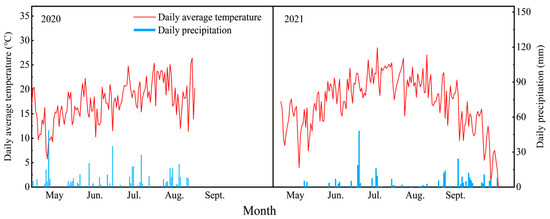
Figure 1.
Daily precipitation and mean daily air temperature throughout the potato growing season.
2.2. Experimental Scheme
The experiment included four treatments: high ridge planting with a furrow mulching straw pattern (HM), partial straw mulching in flat cropping (ZM), partial plastic mulching (PM), and flat plowing on bare ground as the control (CK). Each treatment and control was replicated three times, comprising a total of 12 plots, each measuring 28 m2 (7 m × 4 m). The experiment employed a randomized block design. The straw mulching amount of 6000 kg·ha−1 was mulched on the pre-reserved furrow with a 15 cm height at the emergence stage by hand (Figure 2).
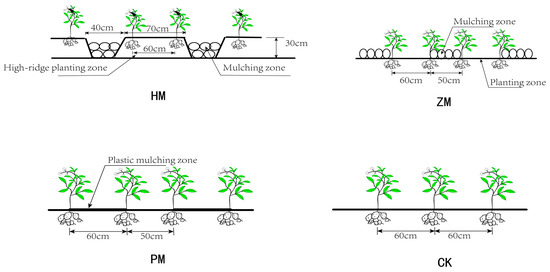
Figure 2.
Schematic diagram of potato field planting.
The potato varieties tested were ‘Xin Daping’ in 2020 and ‘Qinshu No.9’ in 2021. Both are artificially selected varieties, belonging to the late-maturing fresh-eating type. Among them, the ‘Xin Daping’ variety exhibits a semi-upright growth habit with moderate branching, whereas the Qingtu No.9 variety features an upright plant structure with abundant branching and vigorous growth. The planting followed a triangular arrangement, with plants spaced 30 cm apart and rows spaced 60 cm apart. Planting was performed manually in holes to a depth of 15 cm. Based on the growth process of locally cultivated potatoes, their entire growing season is divided into five periods: planting stage (SW), tuber formation stage (TI), tuber enlargement stage (TB), starch accumulation stage (SA), and harvesting stage (MR). The experimental site was dry-farmed without irrigation measures, with manual weeding performed regularly. Field management was consistent with local practices.
2.3. Measurement Indicators and Methods
2.3.1. Soil Water Content and Soil Water Storage Capacity
Soil samples were collected using a 5 cm soil auger from six soil layers (0–20, 20–40, 40–60, 60–90, 90–120, 120–150, and 150–180 cm) at key growth stages of the potato crop, including sowing, tuber formation, tuber expansion, starch accumulation, and harvesting. The soil mass water content was determined using the drying method, and the weighted average soil mass water content was calculated for each treatment.
The soil water storage capacity was calculated using the following formula,
where W is the soil water storage capacity (mm); h is the depth of soil layer (cm); ρ is the soil bulk weight (g·cm−3); ω is the soil mass water content (%).
2.3.2. Soil Temperature Measurement
The HY–1–type right-angle ground thermometer was employed and buried in both the planting and mulching belt of each treatment plot following potato planting, with burial depths of 5 cm, 10 cm, 15 cm, 20 cm, and 25 cm, respectively. Each measurement was conducted on a dry and sunny day, and readings were taken from the soil thermometers in the early morning (07:00), mid-month (14:00), and late evening (19:00) of each reproductive period. The average temperature for each treatment was calculated as the weighted average of the planting and mulching zones.
2.3.3. Potato Yield and Its Trait Indicators
Before potato harvest, 15 plants per plot were manually harvested for seed testing, which involves measuring yield components such as tuber size grading, dry matter content, and fresh tuber weight. According to the weight of individual potatoes, they were divided into large potatoes (>150 g), medium potatoes (75–150 g), and small potatoes (<75 g) [16], and the rates of all levels of potatoes and commercial potatoes were calculated. The yield at harvest was converted to the average of the actual fresh potato yields of the three replicated plots. The dry mass of potato tubers was measured using the method of slicing potatoes, drying them to a constant weight, and then weighing them.
2.3.4. Soil Organic Carbon Measurement
During the potato maturity stage, soil samples were collected from three soil layers (0–10, 10–20, and 20–40 cm) in both the planting zone and the mulching zone using a 5 cm soil drill. After natural air drying, the soil samples were passed through a 0.25 mm sieve and preserved for the determination of soil organic carbon (SOC) and soil particulate organic carbon (POC).
- Soil Organic Carbon
Potassium Dichromate Oxidation Method: The treated soil samples are measured on an organic carbon analyzer.
- 2.
- Soil Particulate Organic Carbon
Sodium Hexametaphosphate Separation Method: Weigh 10 g of the soil sample passed through a 2 mm sieve into a 100 mL centrifuge tube. Add 30 mL of 5 g·L−1 sodium hexametaphosphate solution, shake manually for 15 min, and then oscillate at 180 r/min on a shaker for 16 h. After oscillation, pass it through a 53 μm sieve and wash repeatedly with water until the filtrate is clear. Subsequently, dry it at 55 °C and weigh it to determine its organic carbon content.
2.4. Data Collation and Analysis
Microsoft Excel 2019 (Microsoft Corp., Raymond, Washington, DC, USA) and Origin2021 (OriginLab Corp., Northampton, MA, USA) were used for data organization and graphing. Analysis of variance and correlation analysis were conducted using SPSS 23.0 (IBM Inc., New York, NY, USA), with the Least Significant Difference (LSD) post hoc tests employed for significant difference analysis. The significance level was set at α = 0.05.
3. Results
3.1. Soil Moisture
3.1.1. Soil Water Content
The mulching treatment had a significant effect on the soil moisture during the critical reproductive period of the potato crop, as shown in Figure 3. Compared with that of CK, the average soil water content in the 0–180 cm layer of soil subjected to partial straw mulching in the two growing seasons increased by 2.62% and 3.21% in TI and MR and decreased by 0.21% and 0.02% in TB and SA, respectively. The dual effects of moisture reduction and increase were observed in different layers of soil during all periods of the two growing seasons due to partial straw mulching, but the results were not uniform in the years considered.
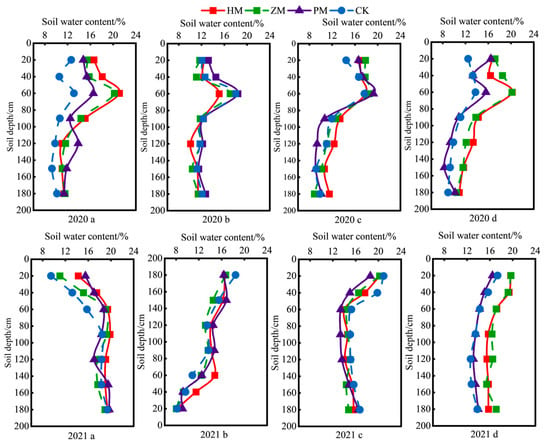
Figure 3.
Distribution of soil water content in the potato critical growth period in two growing seasons: (a) Tuber formation stage; (b) Tuber enlargement stage; (c) Starch accumulation stage; (d) Harvest stage. HM: high ridge planting with a furrow mulching straw; ZM: partial straw mulching in flat cropping; PM: partial plastic mulching; CK: flat plowing on bare ground.
Compared with that in CK, the use of partial straw mulching treatment in 2020 increased the moisture by average values of 34.17%, 8.15%, and 31.55% in the 0–180 cm layer of soil in TI, SA, and MR, respectively, and reduced it by 5.44% in TB. In 2021, partial straw mulching increased the moisture by average values of 14.35%, 8.17%, and 20.12% in the 0–180 cm layer of soil in TI (but not in the 90–120 cm and 150–180 cm layers), TB (but not the 0–20 cm and 120–180 cm layers), and MR, respectively, and reduced the moisture content by 6.52% in SA. Compared with that in PM, the partial cover treatment in 2020 increased the moisture by average values of 13.13%, 9.31%, and 23.37% in TI (excluding the 90–150 cm layer), SA (excluding the 40–60 cm layer), and MR, respectively, and reduced the moisture by 10.33% in TB. In 2021, the partial cover treatment increased the moisture content by average values of 5.53%, 6.64%, 7.74% and 20.46% in TI (excluding the 0–40 cm and 120–180 cm layers of soil), TB (excluding the 0–20 cm and 60–150 cm layers), SA (excluding the 150–180 cm layer), and MR, respectively, while the remaining layers of soil exhibited a decrease in the moisture content. The average soil moisture content of HM increased by 1%, 0.54%, and 0.33% during TI, TB, and SA between partial covers in the two growing seasons compared with that of ZM, respectively, and decreased by 0.19% during MR. HM recorded the highest increases in moisture during TI and MR, of 36.89% and 31.42%, and 13.68% and 18.89%, respectively. Based on the data analysis of soil water content in 2020 and 2021, straw partial mulching had the dual effects of increasing and reducing soil moisture. The effect of increasing soil moisture was more obvious in the key growth period of potato, and straw treatment was higher than film mulching treatment.
3.1.2. Soil Water Storage
Figure 4 shows that mulching had a significant effect on water storage in the 0–180 cm layer of soil of the potato crop. The water storage in this layer obtained its lowest values of 360.05 mm (2020) and 384.49 mm (2021) in TB during cover treatments in the two growing seasons, respectively. Compared with that in CK, mulching significantly increased the soil water storage over the full fertility period in the two growing seasons, with average increases of 46.01 mm in HM, 36.98 mm in ZM, and 22.9 mm in PM. Water storage in the 0–180 cm layer of soil increased by an average of 23.11 mm in HM and 14.08 mm in ZM compared with that in PM over the entire reproductive period. The soil water storage increased by 9.03 mm in HM compared with that in ZM between partial straw mulch treatments. According to the analysis of soil water storage data from 2020 and 2021, it is evident that mulching treatments significantly enhanced soil water storage in potato fields (0–180 cm), demonstrating pronounced water retention effects. Among the treatments, HM yielded the most favorable results, followed by ZM.
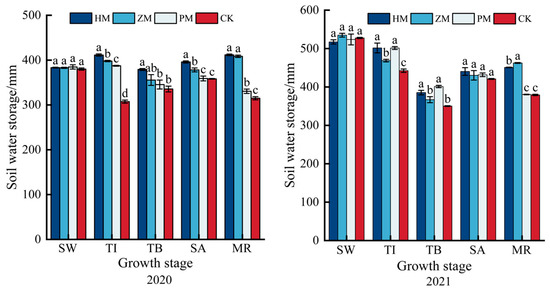
Figure 4.
Water storage in the 0–180 cm soil layer of potato soil in two growing seasons. HM: high ridge planting with a furrow mulching straw; ZM: partial straw mulching in flat crop-ping; PM: partial plastic mulching; CK: flat plowing on bare ground. SW: planting stage; TI: tuber formation stage; TB: Tuber enlargement stage; SA: Starch accumulation stage; MR: Harvesting stage. Different lower letters indicate significant differences between treatments.
3.2. Soil Temperature
There were significant differences (p < 0.05) in the average soil temperature at the 0–25 cm depth throughout the entire growth period among different potato treatments, with the highest average temperature recorded in PM and the lowest in ZM in both growing seasons, as indicated in Table 1. Compared with that of CK, the average temperature of the 0–25 cm layer of soil in PM was higher by 1.23 °C during the entire reproductive period and was lower by 1.42 °C and 2.10 °C in HM and ZM, respectively. The average soil temperature in ZM increased by 0.68 °C compared with that in ZM between partial cover treatments. It can be observed from the analysis of average temperatures in the shallow soil layer (0–25 cm) during the whole growing season in 2020 and 2021 that the PM treatment reduced the average temperature in the shallow soil layer of the potato field throughout the growing season, whereas the local straw mulching treatment had the opposite effect.

Table 1.
Average soil temperature in the 0–25 cm soil layer during the whole growth period.
The soil temperature exhibited a trend of reduction with increasing depth of soil in all treatments, as shown in Figure 5. As the fertility of the crop advanced, the average temperature of the 0–25 cm layer of soil in the critical fertility period in the two growing seasons exhibited a trend of increasing and then decreasing during each treatment. Compared with that in CK, warming effects were evident in the 0–25 cm layer of soil during the two growing seasons in PM, with average increases of 1.24 °C in 2020 and 1.22 °C in 2021. The warming effect was the most pronounced during SA in 2020, with an average increase of 1.13 °C, while the most pronounced warming effect occurred in 2021 during TB, with an increase of 1.55 °C. Both HM and ZM exhibited cooling effects in the 0–25 cm layer of soil during the entire reproductive period, with average reductions of 1.25 °C and 1.58 °C in 2020, and 1.82 °C and 2.38 °C in 2021, respectively. The cooling effect was the most prominent in ZM. The most significant cooling in 2020 occurred during TI, with a drop in temperature of 1.53 °C, while the most prominent cooling of 2.86 °C in 2021 occurred during MR. The differences among the treatments were the greatest in the 5 cm layer of soil during TB in 2020, with a difference of 5.19 °C (PM vs. ZM), followed by SA, with a difference of 5.10 °C (PM vs. ZM). The largest difference was observed in the 5 cm layer of soil during SA in 2021, with a difference of 5.92 °C (PM vs. ZM), followed by the period of tuber formation, with a difference of 5.66 °C (PM vs. ZM).
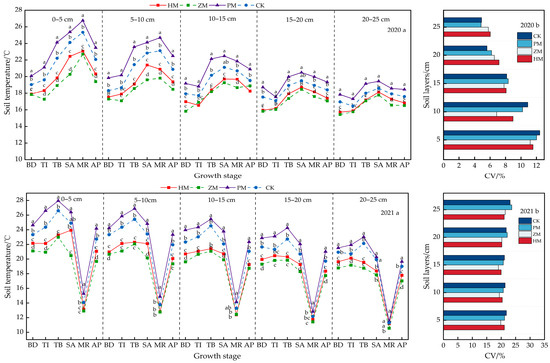
Figure 5.
Variation in soil temperature in the 0–25 cm soil layer at different growth periods. (a) Soil temperature dynamics during the reproductive period for various potato treatments within different soil layers; (b) Coefficient of variation in soil temperature during the reproductive period for various potato treatments within the same soil layer; HM: high ridge planting with a furrow mulching straw; ZM: partial straw mulching in flat crop-ping; PM: partial plastic mulching; CK: flat plowing on bare ground. BD: Budding stage; TI: Tuber initiation stage; TB: Tuber bulking stage; SA: Starch accumulation stage; MR: Maturity; AP: All period; CV: Coefficient of variation. Different lower letters indicate significant differences between treatments (p < 0.05).
3.3. Yield and Indices of Potato Tuber
Mulching significantly increased the potato tuber yield, as indicated in Figure 6. Compared with CK, PM, HM, and ZM treatments increased the yield by average values of 38.68%, 36.91%, and 23.37%, respectively, over the two growing seasons, and the rate of increase in yield was of the order of PM treatment > HM treatment > ZM treatment. ZM and HM treatments had the highest yield between partial covers in 2020 and 2021, respectively, but the average yield of HM treatment was greater than that of ZM treatment over the two growing seasons.
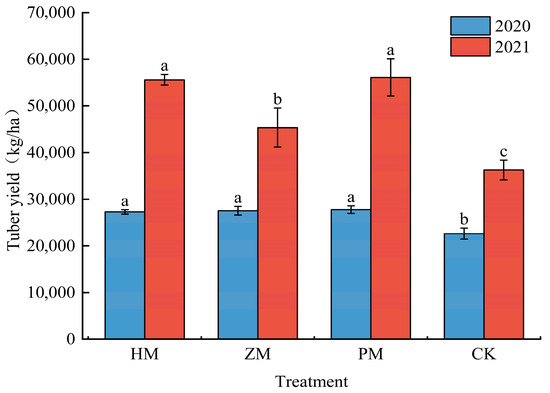
Figure 6.
Potato yield under different mulch cropping methods. HM: high ridge planting with a furrow mulching straw; ZM: partial straw mulching in flat crop-ping; PM: partial plastic mulching; CK: flat plowing on bare ground. Different lower letters indicate significant differences between treatments.
The cover cropping practices significantly influenced the indicators of the potato yield, as shown in Table 2. Compared with those of CK, the yields of potato pieces and dry potato increased by 23.76% to 40.70%, and 13.14% to 34.80% on average, respectively, from partial straw mulching treatment. The rates of production commercial and large potatoes increased by 25.58% to 25.72%, and 45.08% to 45.67% on average, respectively, while the rate of production of medium potatoes (except for HM) and the water use efficiency (WUE) increased by 0.25% and 25.75% on average, respectively, in the two growing seasons. The average increases in the potato yield and dry potato yield due to PM treatment were 42.39% and 28.99%, those in the rate of production of commercial and large potatoes rate were 33.31% and 55.74%, while the average increases in the rate of production medium potato and the WUE were 3.77% and 44.35%, respectively. Between partial covers, the HM treatment increased the potato yield, the dry potato yield, the rate of production of large potatoes, and the WUE by average values of 13.69%, 19.14%, 0.40%, and 15.31%, respectively, compared with those of ZM during the two growing seasons. Based on the analysis of potato yield indicators for 2020 and 2021, it is evident that the PM treatment yielded the most significant increase in production. The partial-cover treatment also demonstrated yield-enhancing effects, with the HM treatment achieving a higher average yield increase than the ZM treatment.

Table 2.
Effects of different mulch cropping methods on potato yield index.
3.4. Soil Organic Carbon
The straw mulching treatments affected the soil organic carbon (SOC) and particulate organic carbon (POC) content in the 0–40 cm soil layer during the potato maturity stage across two growing seasons, and the SOC and POC contents in each treatment gradually decreased with increasing soil depth, as indicated in Figure 7 and Figure 8.
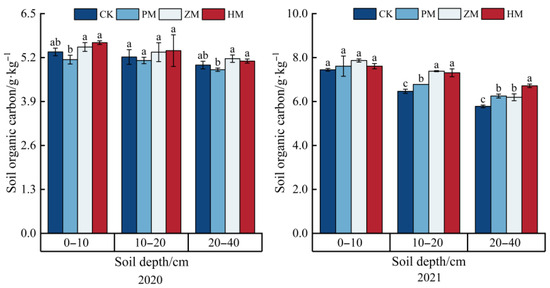
Figure 7.
Changes in soil particulate organic carbon in different soil layers during the maturation stage of potatoes. HM: high ridge planting with a furrow mulching straw; ZM: partial straw mulching in flat crop-ping; PM: partial plastic mulching; CK: flat plowing on bare ground. Different lower letters indicate significant differences between treatments (p < 0.05).
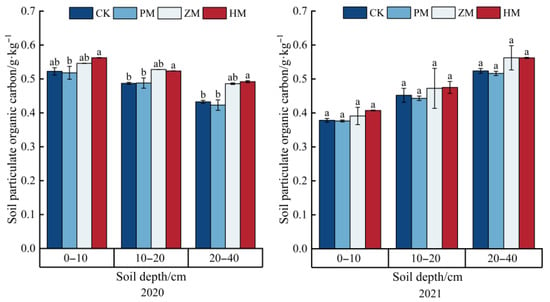
Figure 8.
Changes in soil organic carbon in different soil layers during the maturation stage of potatoes. HM: high ridge planting with a furrow mulching straw; ZM: partial straw mulching in flat crop-ping; PM: partial plastic mulching; CK: flat plowing on bare ground. Different lower letters indicate significant differences between treatments (p < 0.05).
Compared to CK, the straw mulching treatments increased the soil organic carbon (SOC) and particulate organic carbon (POC) in the 0–40 cm soil layer during the potato maturity stage by an average of 6.57% and 7.47%, respectively, across two growing seasons. The HM treatment increased SOC in the 0–40 cm soil layer by 7.09% and POC by 8.17%, while the ZM treatment increased SOC by 6.04% and POC by 6.77%. The magnitude of increase was higher with the HM treatment than with the ZM treatment. Between the two growing seasons, the highest increase in SOC in the 0–40 cm soil layer compared to CK was observed in 2021, reaching 9.74%, while the highest increase in POC was observed in 2020, reaching 9.03%. The performance between soil layers was inconsistent across the two growing seasons. In 2021, the HM treatment significantly increased SOC in the 20–40 cm soil layer by 14.61% compared to CK, while in 2020, it significantly increased SOC in the 0–20 cm soil layer by 4.36%. For POC, significant changes were observed in the 20–40 cm soil layer in 2020, with an increase of 13.71% compared to CK, while in 2021, significant changes were observed in the 0–10 cm and 10–20 cm soil layers, with an average increase of 7.51% compared to CK.
In two growing seasons, compared to the PM treatment, the straw mulching treatments increased the soil organic carbon (SOC) and particulate organic carbon (POC) in the 0–40 cm soil layer by an average of 5.50% and 8.70%, respectively. Among them, the HM treatment increased SOC by an average of 5.99% and POC by 5.02%, while the ZM treatment increased SOC by 9.41% and POC by 7.99%. Between the straw mulching treatments, the HM treatment increased SOC and POC in the 0–40 cm soil layer compared to the ZM treatment in both growing seasons, but there was no significant difference between the two treatments. Combining the results of soil organic carbon measurements in potato fields from 2020 and 2021 reveals that straw mulching treatments contribute to increased soil organic carbon and particulate organic carbon content, thereby improving the quality of the cultivated soil layer to a certain extent.
3.5. Correlation Analysis of Various Indices
As shown in Figure 9, the results of correlation analyses showed that the potato tuber yield and WUE were highly significantly and positively correlated with water storage in the 0–180 cm layer of soil during TI (2020), and during TI and TB (2021). They were also positively but not significantly correlated with the remainder of the reproductive period in the two growing seasons. Moreover, they changed inconsistently with the temperature of the soil stratum in the 0–25 cm layer in the growing seasons. The yield of potato tuber in 2020 was negatively but not significantly correlated with the temperature of the 0–25 cm layer of soil, and positively but not significantly correlated with the soil temperature in 2021 (except for the period of tuber expansion). The dry potato yield was positively correlated with water storage in the 0–180 cm layer of soil in the two growing seasons, positively and non–significantly correlated with it in 2020, significantly or highly significantly positively correlated with it in 2021 during TI and TB and was non–significantly correlated with the soil temperature in the two growing seasons.
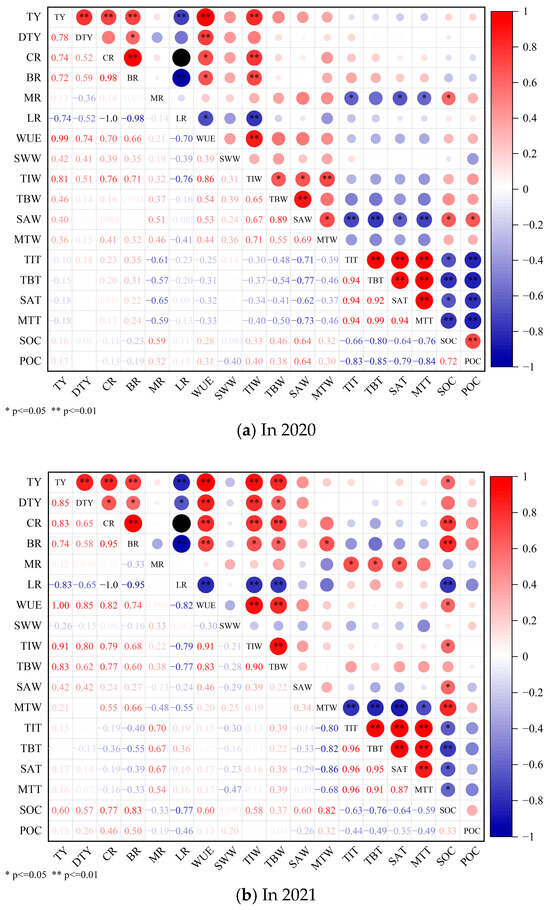
Figure 9.
Correlation between soil water temperature and yield in the key growth period of potato. TY: Tuber yield; DTY; Dry Tuber yield; BR: Big potato rate; MR: Medium potato rate; LR: Little potato rate; CR: Commodity potato rate; WUE: Water use efficiency; SWW: Water storage during sowing time; TIW: Water storage during tuber initiation; TBW: water storage in tuber bulking stage; SAW: Water storage during starch accumulation period; MTW: Water storage during maturity; TIT: Tuber forming stage temperature; TBT: Tuber bulking stage temperature; SAT: Temperature of starch accumulation stage; MTT: Temperature of maturity stage. Red denotes a positive correlation, blue denotes a negative correlation, while the intensity of the colour and the size of the circle indicate the strength of the correlation.
In two growing seasons, the relationship between potato soil organic carbon (SOC) and particulate organic carbon (POC) with soil water storage and temperature exhibited certain patterns. SOC and POC were positively correlated with soil water storage during the tuber formation to maturity stage (except for POC in 2021), indicating that an increase in SOC and POC content can enhance soil water retention capacity. Particularly in 2020, SOC and POC were significantly positively correlated with soil water storage during the starch accumulation stage (r = 0.640 *, r = 0.645 *), suggesting that SOC and POC have a positive impact on the water demand of potato growth. Additionally, SOC and POC were negatively correlated with soil temperature, indicating that SOC and POC help regulate soil temperature, reduce temperature fluctuations, and provide a more stable growth environment for potatoes. In 2021, SOC was significantly or highly significantly positively correlated with soil water storage during key growth stages, while being significantly or highly significantly negatively correlated with soil temperature, further confirming the role of SOC in regulating soil water and temperature.
In terms of potato yield and yield indicators, the impact of SOC and POC varied across different years and growth stages. In 2020, the medium-sized potato rate was significantly positively correlated with SOC during key growth stages (r = 0.59 *), indicating that SOC affects the distribution of potato tuber sizes. In 2021, potato yield, marketable potato rate, large potato rate, and WUE were positively correlated with SOC and POC, with significant or highly significant positive correlations with SOC (r = 0.60 *, r = 0.77 **, r = 0.83 **, r = 0.60 *), indicating that SOC and POC play a positive role in increasing potato yield and water use efficiency.
Additionally, potato yield was highly significantly positively correlated with dry potato yield (r = 0.784 **, r = 0.854 **), large potato rate (r = 0.720 **, r = 0.743 **), commercial potato rate (r = 0.739 **, r = 0.827 **), and water utilization efficiency (r = 0.987 **, r = 0.998 **), and highly significantly negatively correlated with small potato rate (r = −0.739 **, r = −0.827 **) were highly significantly negatively correlated.
4. Discussion
4.1. Effect of Furrow Cover Planting Method on Soil Water Storage
Efficient utilization of precipitation to enhance soil water storage capacity and moisture retention has been a central focus in research about crop production and dryland agriculture in Northwest China [17,18]. Research indicates that mulching and straw mulching effectively reduce soil water evaporation, enhance water retention, and regulate water availability to crops, thereby optimizing water allocation for transpiration [19,20,21]. This mitigates the conflict between soil water availability and crop water requirements, thereby facilitating optimal plant development [22,23,24,25]. Ridge-furrow mulching facilitates precipitation harvesting and mitigates surface evaporation, thereby enhancing soil water storage and the efficiency of precipitation use [26]. The results demonstrate that both mulching and straw-localized mulching treatments significantly augmented soil water storage in potato crops. Soil water storage at depths of 0–180 cm under two growing seasons of mulching treatment reached its lowest point at the tuber enlargement stage, before recovering slightly in the later stages. Water conservation of the planting methods followed the order HM > ZM > PM. This finding is consistent with the research results of Xie Chengjun et al. [27], i.e., straw mulching increases soil moisture content during the seedling to flowering stages of potatoes, thereby improving soil moisture conditions. However, its beneficial effect on soil moisture diminishes during the tuber enlargement stage, only to recover again during the maturity stage. This may be attributed to straw application, which increased ground surface roughness, promoting water infiltration and reducing evaporative moisture loss. Water conservation, as assessed across the planting methodologies, followed the sequence HM > ZM > PM. This outcome may be attributed to straw mulching, which enhanced surface roughness, thereby promoting water infiltration and mitigating evaporative moisture loss [28].
4.2. Effect of Furrow Planting on Soil Temperature
Soil temperature is a critical factor influencing crop growth and development; mulching techniques can ameliorate soil thermal regimes, thereby influencing crop growth to varying degrees [5]. Their thermoregulatory effect diminishes with increasing soil depth [29].
Prior investigations have indicated that the influence of diverse cover cropping methodologies on soil temperature fluctuates based on soil type, prevailing climatic conditions, and the composition of the covering materials [30]. Excessively high soil temperatures diminish root physiological activity, inhibit normal metabolism, and accelerate senescence, thereby impairing efficient nutrient, water, and heat utilization, ultimately affecting yield. The prevailing perspective suggests that straw mulching is implemented to mitigate soil temperature, whereas plastic mulching is employed to increase it. In our experiments, all mulching treatments applied across the two growing seasons demonstrated both cooling and warming effects on soil. Relative to the control (CK), black plastic mulching (PM) increased the average temperature of the 0–25 cm soil layer throughout the potato crop’s reproductive period by 1.23 °C, whereas partial ridge-mulching with straw (HM) and flat mulching (ZM) treatments reduced the average soil temperature by 1.42 and 2.10 °C, respectively. This may have occurred because the straw cover mitigated solar radiation and groundwater–heat exchange, thereby regulating soil temperature fluctuations. In the early stages of tuber development, the potato crop’s temperature rises, subsequently decreasing during the mid and late-growth stages to prevent elevated temperatures from compromising tuber development. The potato crop thrives in cooler environments, and mulching can facilitate heat absorption [31]. Partial coverage of the high ridge treatment furrow straw, which is temperature-dominant, can mitigate the influence of ridges on the soil temperature range, compared to flat crop straw, which reduces the influence of the soil temperature range on the ridge. The function of heat absorption [32], involving partial coverage of the high ridge treatment furrow straw, exerts a predominant influence on soil thermal dynamics by attenuating the temperature fluctuation amplitude of the ridge, thereby moderating soil temperature variations. Compared to flat straw partial coverage, the increased exposed surface area enhances soil–atmosphere water–heat exchange, leading to elevated soil evaporation rates. Consequently, the thermal warming effect is more significant than that observed in flat crop partial coverage treatments.
4.3. Impact of Furrow Cover Cropping Methods on Potato Yield
Mulching enhances the vegetative development of potato [32], thereby augmenting tuber yield [25,33,34], although its effectiveness is contingent upon regional agroecological conditions and specific crop varieties. Chen et al. [35] observed that furrow cover cultivation significantly improves soil water retention, with increases ranging from 5.4% to 15.5%, and enhances monoculture biomass production by 12.8% to 147.4%. Additionally, crop yield experiences an uplift of 51.6% to 88.2%, while water use efficiency is augmented by 68.2% to 111.7% compared to conventional open-field cultivation over two growing seasons. Chen et al. [36] demonstrated that the maximum aggregate potato yield was obtained through the application of ridged mulch furrows supplemented with straw and mulching interventions, both of which significantly enhanced tuber production relative to flat planting configurations. The experimental data demonstrated that potato tuber productivity across the two cultivation cycles was optimized under PM and HM management practices, with ZM following, exhibiting respective mean yield enhancements of 38.68%, 36.91%, and 23.37% relative to the CK. This phenomenon is attributed to the enhanced water conservation capabilities of straw mulching during the reproductive phenophase of Solanum tuberosum. Moreover, this critical developmental stage aligns with a period marked by increased ambient temperatures and precipitation. Straw mulching, which provides a notable soil cooling effect, can modulate soil hydrothermal dynamics, thereby stabilizing soil moisture regimes and potentially augmenting tuber yield [37,38].
4.4. Impact of Furrow Cover Cropping Methods on Soil Quality
Soil organic carbon (SOC) serves as a vital biomarker for soil health and agronomic productivity, representing 10% of the total soil organic carbon pool [39]. The content delineates a state of dynamic equilibrium within the soil’s organic carbon reservoir, characterized by seasonal fluctuations modulated by crop phenology, agronomic management strategies, and tillage methodologies. Increasing soil organic carbon content enhances soil fertility and quality [40] and promotes macroaggregate formation and stabilization. Straw mulching can promote the development of soil macroaggregates, thereby improving soil organic carbon sequestration and increasing particulate organic carbon levels. Fengjuan Cui [41] and Yushan Bu et al. [42] observed that straw mulching enhanced soil organic carbon levels to a certain degree, whereas the impact of plastic mulching on soil organic carbon fractions exhibited variability attributable to differences in experimental site climates, precipitation regimes, crop phenological stages, agronomic management practices, and mulching durations [43]. This study reached similar conclusions. Over the course of two cropping cycles, straw mulching interventions markedly improved soil organic carbon (SOC) and particulate organic carbon (POC) concentrations within the 0–40 cm soil profile compared to the control (CK) and partial mulching (PM) treatments. Among the partial straw mulching strategies, the HM treatment demonstrated the most pronounced enhancement of SOC and POC levels, followed by ZM. Additionally, SOC and its fractions exhibited a decreasing trend with increasing soil depth within the 0–40 cm horizon.
In this study, soil organic carbon and its fractions did not exert a direct effect on potato yield in 2020; however, they demonstrated a robust correlation with soil volumetric water content. Correlation analysis revealed statistically significant or highly significant associations between soil organic carbon, its fractions, and soil moisture levels. The interaction between soil organic carbon and soil moisture appears to be synergistic. Post-straw mulching, the enhancement of soil organic carbon and particulate organic carbon content improves soil quality, thereby increasing potato yields and WUE. Meanwhile, the augmentation of soil organic carbon enhances infiltration and retention of precipitation, reduces evaporative moisture loss from the soil surface, thereby elevating soil moisture availability, which, in turn, promotes tuber development and overall crop productivity.
5. Conclusions
First, compared with the CK, the partial straw mulching treatment significantly increased tuber yield, marketable tuber rate, and WUE. Furthermore, the HM treatment outperformed the ZM treatment in all these indicators. Second, the mulching treatments markedly enhanced water storage during the entire potato growth period, improving soil moisture conditions. Compared with the CK, the HM treatment yielded the most pronounced improvement, increasing soil water storage by 43.04 mm, followed by the ZM treatment. However, partial straw mulching reduced shallow-layer (0–25 cm) soil temperatures during the whole growth period. Compared with the CK, the PM treatment increased the average shallow-layer soil temperature by 1.23 °C during the whole growth period, while the HM and ZM treatments reduced it by 1.42 °C and 2.10 °C, respectively. Finally, straw mulching significantly enhanced soil organic carbon and particulate organic carbon in the plow layer (0–40 cm) during the maturity stage. The enhancement magnitude was higher with the HM treatment than with the ZM treatment relative to the CK, though no significant difference existed between the HM and ZM treatments.
Therefore, in the potato cultivation of the Longzhong region in northwest China, the planting pattern of high ridge with partial straw mulching has the effects of water retention, soil quality improvement, and temperature regulation on potato field soil, while also significantly increasing potato yield. However, this study only analyzed indicators such as soil moisture, temperature, organic carbon, and tuber yield under straw partial-cover treatments with different ridge heights and plastic mulch treatments. The measured indicators are relatively conventional and unsystematic, so it is imperative to comprehensively consider production practice needs in future research. Particularly within the straw-covered circular agriculture model, microbial activity and nitrogen utilization are crucial factors influencing the soil microenvironment and crop yields via soil water and thermal conditions. We plan to incorporate these indicators in subsequent research, whilst also addressing the soil pest and disease issues associated with long-term straw coverage.
Author Contributions
Data curation, L.H., X.Y. and J.M.; Formal analysis, J.M. and Z.D.; Funding acquisition, C.H. and J.M.; Investigation, C.H.; Methodology, Z.W.; Project administration, C.H.; Supervision, C.H.; Writing: original draft, J.M. and L.H.; Writing: review and editing, C.H., J.M., X.Y., Z.D. and Z.W. All authors have read and agreed to the published version of the manuscript.
Funding
This research was funded by “the key Gansu Agricultural University Young Mentor Support Fund Project (number GAU-QDFC-2023-13)”, “Gansu Province Water Conservancy Science Experiment Research and Technology Promotion Project (25GSLK054)”, and “the Discipline Construction Team for Efficient Utilization of Crop Water and Water Conservation Mechanisms”.
Data Availability Statement
The data that support the findings of this study are available from the corresponding author upon reasonable request.
Conflicts of Interest
No conflicts of interest pertain to the submission of this manuscript, and the manuscript has been approved by the authors for publication. We would like to declare that the work described is original research that has not been published previously and is not under consideration for publication elsewhere.
References
- Zhang, S.-M.; Ning, T.-Y.; Liu, Z.; Wang, B.; Sun, T.; Zhang, X.-P.; He, Z.-K.; Yang, Y.; Mi, Q.-H. Weed Suppression and Thermohygric Effects of Different Types of Plastic Mulch and Their Impact on Potato Yield and Quality. Acta Agron. Sin. 2017, 43, 571–580. [Google Scholar] [CrossRef]
- Yang, Y.; Li, J.M.; Ran, P.; Dong, H.J.; Chen, X.H.; Ma, X.F. Study on the Planting Model of Straw Covered Potato in Dry Farming Area of Anding District. Chin. Potato J. 2020, 34, 86–93, (In Chinese with English Abstract). [Google Scholar]
- Ran, P.; Wang, C.G. Practice and Reflections on the Development of Dryland Agriculture in Anding District. Gansu Agric. Sci. Technol. 2017, 48, 59–63, (In Chinese with English Abstract). [Google Scholar]
- Kong, M.; Huang, M.J.; Zhang, Z.X.; Long, J.; Siddique, K.H.M.; Zhang, D.-M. Effects of plastic film mulching on soil microbial carbon metabolic activity and functional diversity at different maize growth stages in cool, semi-arid regions. Front. Microbiol. 2024, 15, 1492149. [Google Scholar] [CrossRef]
- Tang, Z.; Lu, J.; Xiang, Y.; Shi, H.; Sun, T.; Zhang, W.; Wang, H.; Zhang, X.; Li, Z.; Zhang, F. Farmland mulching and optimized irrigation increase water productivity and seed yield by regulating functional parameters of soybean (Glycine max L.) leaves. Agric. Water Manag. 2024, 298, 108875. [Google Scholar] [CrossRef]
- Ma, Z.; Ma, J.; Chai, Y.; Song, W.; Han, F.; Huang, C.; Cheng, H.; Chang, L. Mulching Improves the Soil Hydrothermal Environment, Soil Aggregate Content, and Potato Yield in Dry Farmland. Agronomy 2024, 14, 2470. [Google Scholar] [CrossRef]
- Ávila-Valdés, A.; Quinet, M.; Lutts, S.; Martínez, J.P.; Lizana, X.C. Tuber yield and quality responses of potato to moderate temperature increase during Tuber bulking under two water availability scenarios. Field Crops Res. 2020, 251, 107786. [Google Scholar] [CrossRef]
- Liu, H.; Wang, X.; Shi, Q.; Liu, Y.; Lei, H.; Chen, Y. Microplastics in arid soils: Impact of different cropping systems (Altay, Xinjiang). Environ. Pollut. 2022, 303, 119162. [Google Scholar] [CrossRef]
- Zhao, Z.Y.; Wang, P.Y.; Xiong, X.B.; Irum, M.; Mo, F.; Cao, J.; Wang, N.; Tao, H.-Y.; Hao, M.; Wang, S.; et al. Size and concentration effects of polythene plastic residues on soil physiochemical traits and maize productivity: A three-year appraisal. J. Clean. Prod. 2024, 435, 10. [Google Scholar] [CrossRef]
- Yang, Y.; Yin, M.; Guan, H. Responses of Soil Water, Temperature, and Yield of Apple Orchard to Straw Mulching and Supplemental Irrigation on China’s Loess Plateau. Agronomy 2024, 14, 1531. [Google Scholar] [CrossRef]
- Kader, M.; Nakamura, K.; Senge, M.; Mojid, M.; Kawashima, S. Soil hydro-thermal regimes and water use efficiency of rain-fed soybean (Glycine max) as affected by organic mulches. Agric. Water Manag. 2019, 223, 105707. [Google Scholar] [CrossRef]
- Qi, Z.; Song, F.; Zhang, Z.; Liu, M.; Yin, Z.; Li, A. Effects of Conservation Tillage on Soil Water-Heat Effects and Maize Yield in Cold-Climate Black Soil Regions. Trans. Chin. Soc. Agric. Mach. 2022, 53, 380–389. [Google Scholar]
- Dong, F.; Lou, G.; Lu, J.X.; Li, F.; Zhang, J.C.; Li, J.H.; Duan, Z.Q. Alternate row mulching optimizes soil temperature and water conditions and improves wheat yield in dryland farming. J. Integr. Agric. 2018, 17, 2558–2569. [Google Scholar] [CrossRef]
- Qian, Y.P.; Tian, H.H.; Cheng, H.B.; Ma, J.T.; Chai, Y.W.; Li, Y.W.; Chai, S.X. Effects of straw mulching and sowing methods on water consumption characteristics and yield of potato in arid region of Northwest China. Chin. J. Eco-Agric. 2020, 28, 826–834, (In Chinese with English Abstract). [Google Scholar]
- Li, H.; Chai, S.X.; Chang, L.; Cheng, H.B.; Han, F.X.; Chai, Y.W. Effects of earthing up on yield and water use efficiency of potato under straw strip mulching planting pattern. Trans. Chin. Soc. Agric. Eng. 2019, 35, 107–115, (In Chinese with English Abstract). [Google Scholar]
- Han, F.; Chang, L.; Chai, S.; Yang, C.; Cheng, H.; Yang, D.; Li, H.; Li, B.; Li, S.; Song, Y.; et al. Effect of straw strip covering on ridges on soil water content and potato yield under rain-fed semiarid conditions. Chin. J. Ecol. Agric. 2016, 24, 874–882. [Google Scholar] [CrossRef]
- Cao, L.; Nie, Z.; Liu, M.; Wang, L.; Wang, Q. The ecological relationship of groundwater–soil–vegetation in the oasis–desert transition zone of the Shiyang River Basin. Water 2021, 13, 1642. [Google Scholar] [CrossRef]
- Wei, W.; Liu, C.F.; Liu, C.Y.; Xie, B.B.; Zhou, J.J.; Nan, S.X. Spatio-temporal analysis of ecological vulnerability in arid region: A case study of Hexi corridor, northwest China. Hum. Ecol. Risk Assess. Int. J. 2022, 28, 564–593. [Google Scholar] [CrossRef]
- Ren, A.T.; Zhou, R.; Mo, F.; Liu, S.T.; Li, J.Y.; Chen, Y.L.; Zhao, L.; Xiong, Y.C. Soil water balance dynamics under plastic mulching in dryland rainfed agroecosystem across the Loess Plateau. Agric. Ecosyst. Environ. 2021, 312, 107354. [Google Scholar] [CrossRef]
- Gu, X.B.; Cai, H.J.; Fang, H.; Li, Y.P.; Chen, P.P.; Li, Y.N. Effects of degradable film mulching on crop yield and water use efficiency in China: A meta-analysis. Soil Tillage Res. 2020, 202, 104676. [Google Scholar] [CrossRef]
- Li, R.; Chai, S.X.; Chai, Y.W.; Li, Y.W.; Lan, X.M.; Ma, J.T.; Cheng, H.B.; Chang, L. Mulching optimizes water consumption characteristics and improves crop water productivity on the semi–arid Loess Plateau of China. Agric. Water Manag. 2021, 254, 106965. [Google Scholar] [CrossRef]
- Yang, Y.J.; Du, W.; Cui, Z.Y.; Lei, S.; Lei, T.; Lv, J.L. Effects of plastic film mulching on soil water use efficiency and wheat yield in the Loess Plateau of China. Arid Land Res. Manag. 2020, 34, 405–418. [Google Scholar] [CrossRef]
- Chen, Y.Z.; Tian, H.H.; Li, Y.W.; Chai, Y.W.; Li, R.; Cheng, H.B.; Chang, L.; Chai, S.X. Effects of Strip–Tillage and Ridged Planting on Yield and Water Use Efficiency of Potatoes in Dryland Conditions. Acta Agron. Sin. 2019, 45, 714–727, (In Chinese with English Abstract). [Google Scholar] [CrossRef]
- Huang, X.; Wang, H.; Zhang, M.; Horn, R.; Ren, T. Soil Water Retention Dynamics in a Mollisol during a Maize Growing Season under Contrasting Tillage Systems. Soil Tillage Res. 2021, 209, 104953. [Google Scholar] [CrossRef]
- Cheng, H.B.; Niu, J.B.; Chai, S.X.; Chang, L.; Yang, C.G. Effect of different mulching materials and methods on soil moisture and temperature and grain yield of dryland spring wheat in northwestern China. Acta Pratacult. Sin. 2016, 25, 47–57. [Google Scholar]
- Bhatt, R.; Singh, P.; Hossain, A.; Timsina, J. Rice–wheat system in the northwest Indo–Gangetic plains of South Asia: Issues and technological interventions for increasing productivity and sustainability. Paddy Water Environ. 2021, 19, 345–365. [Google Scholar] [CrossRef]
- Chengjun, X.; Ping, W.; Juan, C. Effects of Different Mulching Methods on Soil Water and Heat Conditions and Potato Yield in Farmland. Bull. Soil Sci. 2019, 50, 1151–1158. [Google Scholar]
- Liu, Y.H.; Jia, Z.K.; Zhang, R.; Liu, T.; Ma, X.L. Effects of dual–mulching with plastic film and other mulching materials on soil water and WUE in semiarid region. Agric. Res. Arid Areas 2010, 28, 152–157, (In Chinese with English Abstract). [Google Scholar]
- Yin, W.; Qiang, C.; Yao, G.; Fan, Z.L.; Hu, F.L.; Fan, H.; Zhao, C.; Yu, A.; Coulter, J.A. Straw and plastic management regulate air–soil temperature amplitude and wetting–drying alternation in soil to promote intercrop productivity in arid regions. Field Crops Res. 2020, 249, 107758. [Google Scholar] [CrossRef]
- Huo, Y.Z.; Ding, C.L.; Yin, H.; Han, C.L. Effects of different mulching materials on soil moisture-heat condition and yield of potato. J. Arid Land Resour. Environ. 2019, 33, 90–94, (In Chinese with English Abstract). [Google Scholar]
- Wang, X.W.; Hou, X.Q.; Li, W.Y.; Hu, X.H.; Li, X.G.; Yang, Z.; Li, R. Effect of environmental-friendly materials mulch on potato growth and their degradation properties in dry-farming areas. Agric. Res. Arid Areas 2018, 36, 86–92, (In Chinese with English Abstract). [Google Scholar]
- Liu, C.J.; Hou, S.L.; Zhen, J.M.; Zheng, Y.A.; Wang, C.X.; Li, H.; Zhang, P.F. Status Quo and Control Measures for Plastic Mulch Pollution of Cotton Field in South Xinjiang. Agric. Eng. 2018, 8, 45–51, (In Chinese with English Abstract). [Google Scholar]
- Wang, J.; Jun, F.; Wang, H.; Wang, X.; Xing, Y.Z.; Gao, Y.Q.; Hao, M.D. Dual–mulching under no-tillage promotes maize root growth and improves yield by optimizing soil hydrothermal conditions in semi-arid regions. Agric. Water Manag. 2025, 312, 109428. [Google Scholar] [CrossRef]
- Huang, K.; He, X.Q.; Li, D.M.; Wang, J.; He, W.C.; Liu, Q.L.; Tan, W.J.; Han, J.R. Effects of Different Mulching Methods on Characteristics of Growth, Yield and Quality for Potato in Semi-arid Area of Longzhong. Chin. Potato J. 2017, 31, 272–277, (In Chinese with English Abstract). [Google Scholar]
- Chen, Y.Z.; Chai, S.X.; Tian, H.H.; Chai, Y.W.; Li, Y.W.; Chang, L.; Cheng, H.B. Straw strips mulch on furrows improves water use efficiency and yield of potato in a rainfed semiarid area. Agric. Water Manag. 2019, 21, 142–151. [Google Scholar] [CrossRef]
- Chen, C.; Li, R.; Li, F.; Yang, W.W.; Hou, X.Q. Influences of soil hydrothermal effect on dryland potato growth and yield under various ridge and furrow mulch conditions. J. Drain. Irrig. Mach. Eng. 2020, 38, 1160–1166. [Google Scholar]
- Li, R.; Hou, X.Q.; Jia, Z.K. Effects of Dual–mulching of Ridge and Furrow on Soil Fertility and Maize Yield in the Weibei Tablelands. Acta Pedol. Sin. 2017, 54, 1259–1268. [Google Scholar]
- Han, F.X.; Zhang, Y.H.; Chang, L.; Chai, Y.W.; Bao, Z.Y.; Cheng, H.B.; Chai, S.X.; Chang, F.G.; Chang, G.H.; Yang, R.Q. Mulching Practice Regulates the Soil Hydrothermal Regime to Improve Crop Productivity in the Rainfed Agroecosystem of the Loess Plateau in China. Agriculture 2024, 15, 76. [Google Scholar] [CrossRef]
- Oechaiyaphum, K.; Hayat, U.; Rajendra, S.; Avishek, D. Impact of long-term agricultural management practices on soil organic carbon and soil fertility of paddy fields in Northeastern Thailand. Geoderma Reg. 2020, 22, e00307. [Google Scholar] [CrossRef]
- Ye, Y.S.; Huang, C.X.; Chai, S.X.; Chang, L.; Ma, J.T.; Ma, J.H.; Li, Y.Z. Effects of straw strip mulching on soil characteristics and yield of winter wheat in dryland. Agric. Res. Arid Areas 2021, 39, 146–152, (In Chinese with English Abstract). [Google Scholar]
- Wang, X.D.; Zhuang, J.J.; Liu, B.Y.; Li, S.S.; Zhao, X.; Liu, Y.; Zhang, H.L. Residue returning induced changes in soil organic carbon and the influential factors in China’s croplands: A meta-analysis. J. China Agric. Univ. 2020, 25, 12–24, (In Chinese with English Abstract). [Google Scholar]
- Lin, L.; Wang, N.J.; Chu, X.S.; Feng, H.; Chen, H.X. Plastic film-mulched ridges and straw–mulched furrows increase soil carbon sequestration and net ecosystem economic benefit in a wheat-maize rotation. Agric. Ecosyst. Environ. 2023, 344, 108311. [Google Scholar]
- Fu, X.; Wang, J.; Liu, Q.Q.; Li, R.R. Effect of Straw and Plastic Film Mulching on Aggregate Size Distribution and Organic Carbon Contents in a Rainfed Corn Field. Chin. J. Soil Sci. 2016, 47, 405–413, (In Chinese with English Abstract). [Google Scholar]
Disclaimer/Publisher’s Note: The statements, opinions and data contained in all publications are solely those of the individual author(s) and contributor(s) and not of MDPI and/or the editor(s). MDPI and/or the editor(s) disclaim responsibility for any injury to people or property resulting from any ideas, methods, instructions or products referred to in the content. |
© 2025 by the authors. Licensee MDPI, Basel, Switzerland. This article is an open access article distributed under the terms and conditions of the Creative Commons Attribution (CC BY) license (https://creativecommons.org/licenses/by/4.0/).